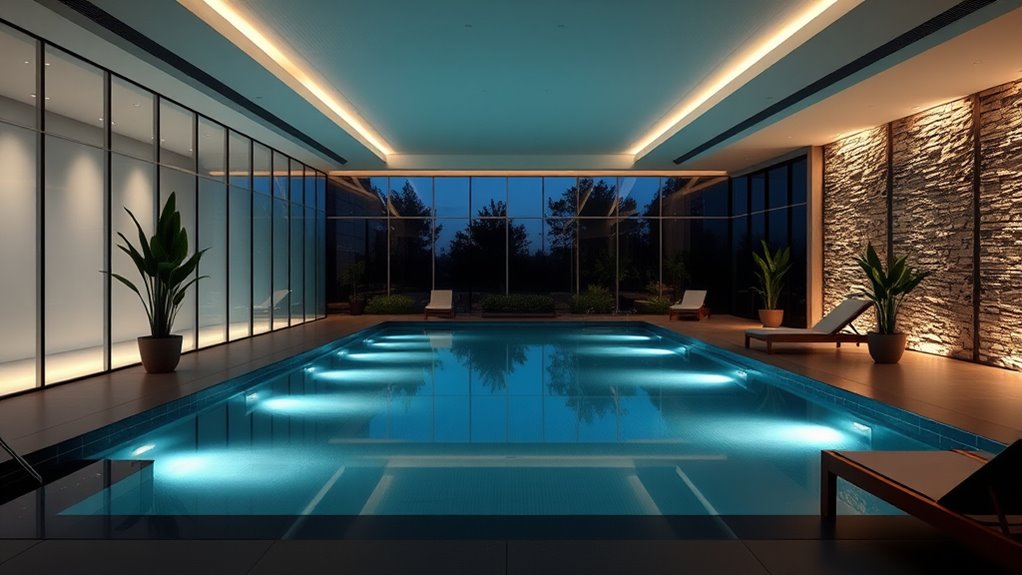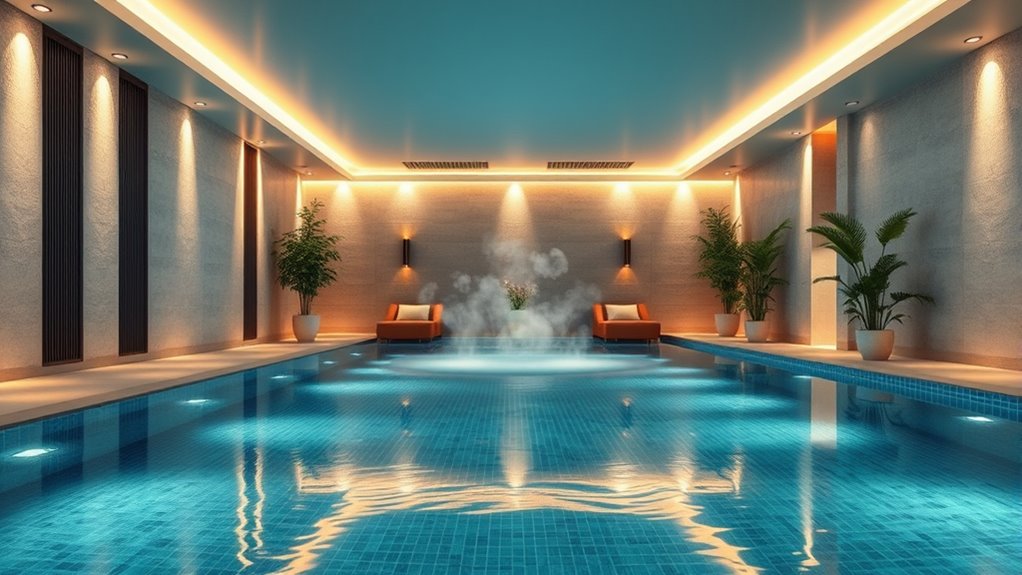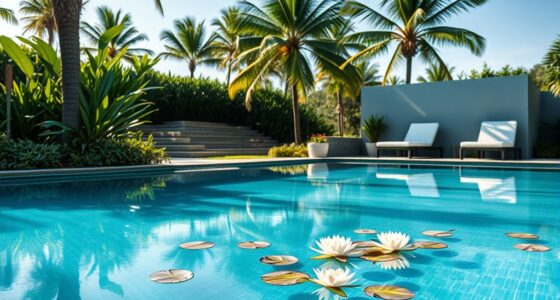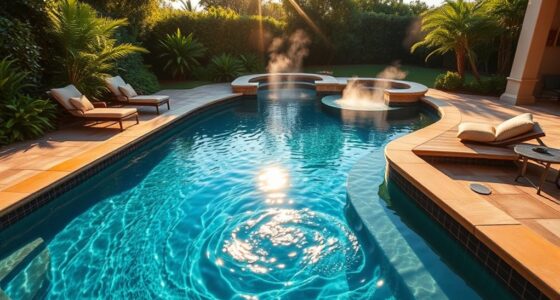To manage humidity in your indoor pool without sacrificing style, focus on smart design choices like moisture-resistant lighting fixtures and layered lighting to enhance ambiance. Incorporate high-quality dehumidifiers and make sure your ventilation system is efficient and well-maintained. Use architectural elements that blend functionality with aesthetics, and regularly inspect filters and equipment. When you pay attention to both airflow and decor, you create a luxurious, comfortable space that stays dry and beautiful—there’s more to discover to perfect your indoor oasis.
Key Takeaways
- Incorporate industrial-grade dehumidifiers and efficient ventilation to control moisture while maintaining sleek, integrated design elements.
- Choose moisture-resistant lighting fixtures, like sealed LED lights, that enhance ambiance without compromising style.
- Use layered, architectural lighting to highlight water features and create a luxurious atmosphere.
- Regularly maintain filters, equipment, and airflow systems to prevent mold and moisture buildup without cluttering the space.
- Select high-quality, moisture-resistant materials and finishes that blend functionality with modern, stylish aesthetics.

Creating an indoor pool can transform your home into a luxurious retreat, providing year-round relaxation and recreation. But along with the beauty and convenience comes the challenge of managing humidity and moisture. Without proper planning, excess humidity can lead to mold, peeling paint, and damage to your home’s structure. To keep your space both stylish and functional, focus on effective pool maintenance and smart lighting design that work together to control moisture while enhancing the aesthetic appeal.
Pool maintenance is vital for keeping your indoor pool in top condition and preventing humidity-related issues. Regularly cleaning filters, balancing water chemistry, and removing debris help guarantee the water stays clear and safe. Proper circulation and filtration minimize the release of moisture into the air, reducing the risk of mold growth. Incorporating dehumidification systems, like industrial-grade dehumidifiers, can be a game-changer. These units actively remove excess moisture from the air, creating a comfortable environment without sacrificing style. You’ll want to guarantee your pool’s ventilation system is efficient, as good airflow helps maintain ideal humidity levels and keeps the space fresh. Regularly inspecting and maintaining your pool equipment not only prolongs its life but also prevents moisture buildup that could damage your home.
Lighting design plays a vital role in managing humidity and transforming your indoor pool into an inviting oasis. Thoughtful lighting can improve visibility and set the mood, but it also impacts moisture control. Choose fixtures made from moisture-resistant materials, such as LED lights with sealed enclosures, to prevent corrosion and electrical issues. Highlight architectural elements or water features with layered lighting, which adds depth and ambiance without compromising functionality. Proper placement of lights near ventilation outlets or dehumidifiers can help monitor moisture levels visually, making it easier to identify when adjustments are needed. Incorporating dimmable lighting not only adds a touch of elegance but allows you to adapt the atmosphere depending on your activity — whether it’s a relaxing evening swim or a lively party.
Frequently Asked Questions
How Can I Prevent Mold Growth Around My Indoor Pool?
To prevent mold growth around your indoor pool, you should prioritize good air circulation and mold prevention. Use exhaust fans and dehumidifiers to keep humidity levels low, ideally between 50-60%. Regularly ventilate the room, wipe down surfaces, and fix leaks promptly. By maintaining proper airflow and moisture control, you’ll reduce mold risk while keeping your space stylish and comfortable.
What Are the Best Dehumidification Options for Small Indoor Pools?
For small indoor pools, the best dehumidification options include compact dehumidifiers with adjustable settings. You should place the dehumidifier near the pool but away from direct water splashes, ensuring ideal dehumidifier placement. Incorporate moisture sensors to monitor humidity levels and automatically adjust the dehumidifier’s operation. This setup maintains perfect humidity, prevents mold, and keeps your space stylish and comfortable without sacrificing aesthetics or functionality.
How Often Should I Service Indoor Pool Humidity Control Systems?
You should service your indoor pool humidity control systems at least quarterly, ensuring ideal pool maintenance and ventilation system performance. Regular inspections help catch issues early, prevent mold growth, and maintain air quality. Clean filters, check dehumidifiers, and verify proper operation to keep humidity levels balanced. Consistent servicing not only prolongs system lifespan but also keeps your pool area comfortable, safe, and stylish without sacrificing function.
Can Aesthetic Design Features Affect Humidity Management?
Aesthetic design features definitely impact humidity management. You can incorporate decorative vents that blend seamlessly with your pool area’s style, ensuring proper airflow without sacrificing aesthetics. Stylish dehumidifiers not only control moisture effectively but also serve as design statements. By choosing these visually appealing options, you maintain a beautiful space while managing humidity levels, keeping your indoor pool comfortable and visually cohesive.
Are There Eco-Friendly Ways to Control Humidity Indoors?
Did you know that eco-friendly ways can naturally control humidity? You can use natural ventilation to circulate air and reduce moisture buildup, or incorporate plant-based solutions like lush, moisture-absorbing plants to maintain a balanced indoor environment. These methods not only save energy but also create a calming, natural aesthetic that complements your indoor pool area beautifully. Embrace these green options and enjoy a healthier, more sustainable space.
Conclusion
Just like maintaining a lush garden requires balancing water and sunlight, managing humidity in your indoor pool keeps your space beautiful and functional. I once visited a home where a sleek, stylish pool was complemented by a clever ventilation system—transforming a potential damp mess into a stunning retreat. When you prioritize humidity control alongside your design, you create a space that’s both luxurious and comfortable. With the right ideas, your indoor pool becomes a true oasis—without sacrificing style.









